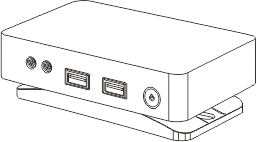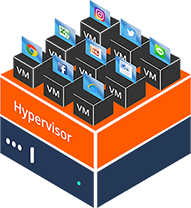How to Use vCloudPoint Zero Clients
The installation of vCloudPoint zero client is easy. Just connect the zero client to the necessary peripherals, and you are ready to access a virtual desktop with given user credentials. There are some installations and configurations needed to be done at the server side to suits your back-end infrastructure.
More about vCloudPoint Zero Client
-
How is the performance of the remote desktop on a zero client?
A zero clients offers nothing locally but just enable users to connect to a remote desktop. In other words, the residing hardware of a zero client does not act on jobs of processing locally, but only to initialize a conversation with the network, begin network protocol processes, and display desktop output. Therefore, the hardware specifications of a zero client itself does not contribute to the remote desktop performance. There are a few aspects that can help with good performance of the remote desktop: well-configured host, low latency & high-bandwidth network, and high efficient remote display protocol. Of the above 3 aspects, only the display protocol is determined by the zero clients. vCloudPoint zero clients utilize our innovative DDP (Dynamic Desktop Protocol) for remote desktop display. This protocol is purpose-built for zero clients and is designed to make efficient use of the network bandwidth and host resources, delivering a user experience that is indistinguishable from using a PC. With DDP, vCloudPoint zero client users can edit documents, chat on IM, write emails, browse websites, enjoy songs& movies, handle graphic designs and use USB devices as they can do on a regular PC.
How to use USB devices on the zero clients?USB devices that are tested to work on the vCloudPoint zero clients:
Storage Devices, USB Hubs, Single, Multi-functional & Dot Matrix Printers,Smart Card Readers, Office &
POS Scanners, Single Touch Screens, U keys, Parallel to USB Converters, etc. An external power supply
may be required for devices with high power consumption.Click to download the list of tested USB devices. Other USB devices that are not listed but functions in the same way are supposed to be supported as well.
Using USB devices with vCloudPoint zero clients:
To use USB devices with vCloudPoint zero clients, you simply install their native driver on the host system as you normally do when using a PC. NO extra drivers are required for the zero clients. vCloudPoint USB redirection technology allows USB devices to work on the zero clients as well as on the host.
Printing devices and storage connected to shared host can be accessed by all client users. Printing devices connected to the zero client can be accessed by all other users but storage devices connected to the zero client can be accessed to the current user only due to vCloudPoint’s vCell User Isolation technology.
Does vCloudPoint zero client support connection through wireless LAN.You can connect the zero clients through wireless network by attaching a compatible external USB antenna to it. There are two ways for you to get the external USB antenna.
1, You can purchase the external USB antenna from your local vCloudPoint dealer.
2, Any antenna that is built with RTL8188EUS chip and connects with USB 2.0 standard is supported by vCloudPoint zero clients.
Given blow is the specification of the external USB antenna:
Connection USB2.0 Chip RTL8188EUS Antenna External 5dBi antenna Antenna standard IEEE 802.11g IEEE 802.11b IEEE 802.11n Speed 11b:1/2/5.5/11 Mbps 11g:6/9/12/18/24/36/48/54 Mbps 11n: up to 150 Mbps Distance up to 200 meters indoor Frequency range 2.4~2.4835GHZ Working channel 1~14 Security features WPA-PSK/WPA2-PSK WPA/WPA2 64/128/152bit WEP encryption Power 2.5W Steps to configure external WIFI:
1, attach the USB antenna to the zero client;
2, reboot the zero client;
3, go to the “Network” page and you will see the WIFI option coming up. See pictures below.
(the WIFI option will automatically display on Network page once the WIFI module is detected on device boot.)
Note: although vCloudPoint offers a wireless option, customers are strongly recommended to use vCloudPoint zero clients with wired connection, as user experience may significantly compromised due to the unreliable and high latency of most wireless network.


